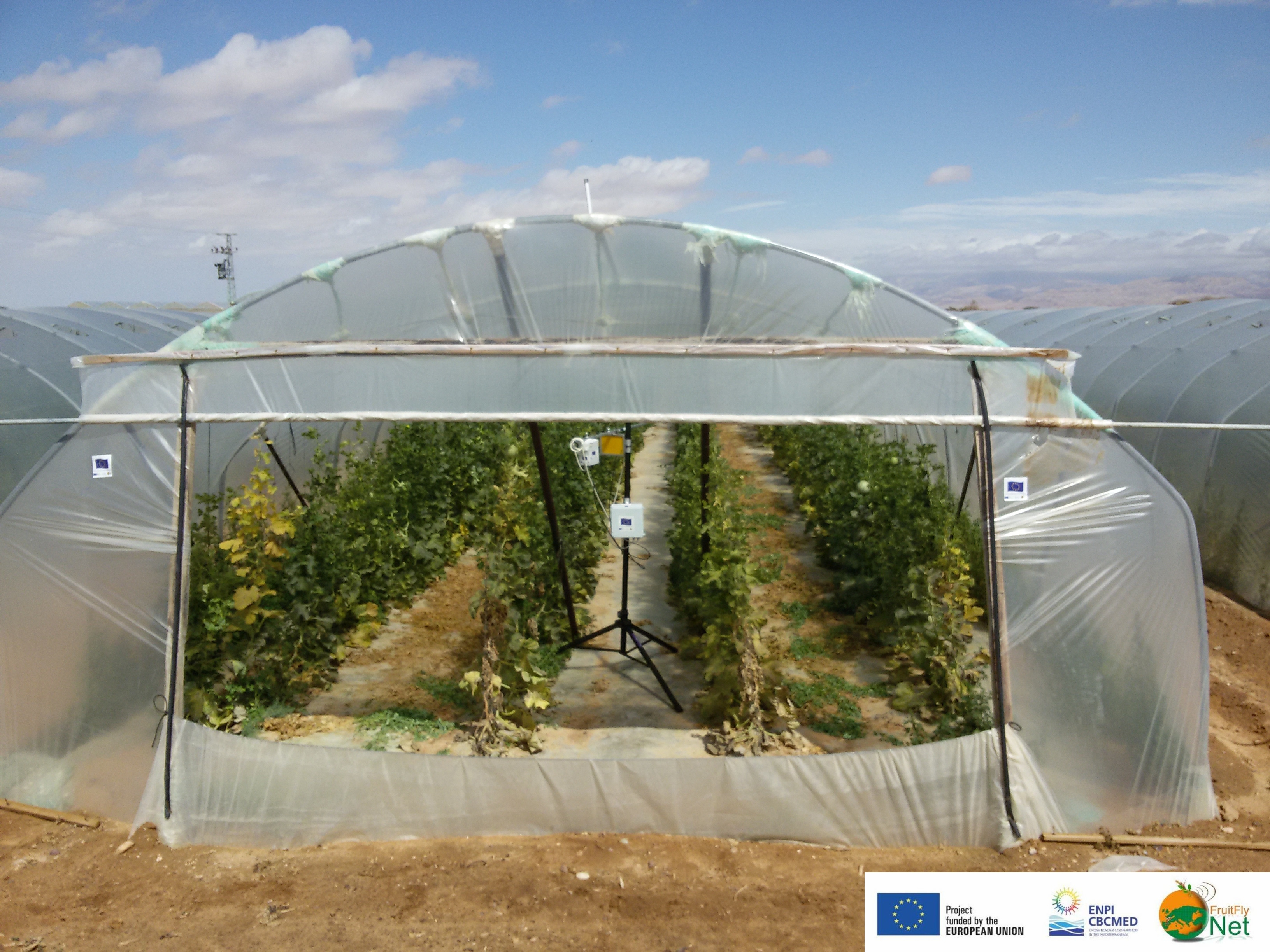"Faster and localized decisions on fruit fly management", Full announcement on the first ReTIC
March, 2015
The first fruit fly Real Time Insect Counting (ReTIC) Traps were deployed in melon tunnels in the Arava, Israel. The yellow-sticky ReTIC trap was developed by the FruitFlyNet Israeli team from the Agricultural Research Organization (ARO). Its aim is to provide wire-less automatic monitoring of fruit fly pests that have no specific attractants.
Fruit fly monitoring data is fed into a Decision Support System (DSS) which will help farmers take decisions on the timing and location of pest management. ReTIC systems can provide ‘Real Time” information on the pests status at any time without the need of human scouting. At this stage of the development, the digital image is sent to a server and the image is visually analyzed by a human expert in its office (‘semi-automatic”). We expect that in the future, identification and counting of insects will be performed automatically by an algorithm that will identify the specific insect organism in the image. The ReTIC system in the Arava is expected to help develop management strategies against the invasive Ethiopian fruit fly, Dacus ciliates (InvasiveFlyNet). ReTIC and DSS will be integrated into LAS (Location-Aware Systems) in different crops (deciduous, olive, cherry, and melon) to drastically reduce pesticide utilization while preserving fruit quality.
Concerning the ReTIC Mr. Rami Sadeh, farmer in Arava, quoted that “The automatic trap will provide us with Real Time Insect Counting abilities, and will allow us to take faster and localized decisions on the management of fruit flies, dropping the use of pesticides”.
Prof. Zvika Mendel, Scientist in ARO, stated that “Flow of real-time information about insect pest situation from the field to growers and pest managers using the ReTIC (Real Time Insect Counting) trap will revolutionize the monitoring and decision making. ReTIC will turn insect pest management more efficiently and environmentally friendly in Israel and other areas. This “intelligent” trap was recently developed in the ARO for fruit flies management in greenhouse crops. ReTIC is a shining example for successful collaboration between experts of different research fields and a joined effort by scientists from several countries. I was highly encouraged to see this idea starting to “take off””.
On the occasion of this milestone Prof. of Networking & ICT in Agriculture and Project Coordinator, Theodore Tsiligiridis, stated that “Agriculture and related industries are fields that can greatly benefit by the adoption of new, harmonized practices. Without the cross border-cooperation it would be difficult to create such a core of scientists who are working together effectively on the objectives of FruitFlyNet.
Most of the target species of FruitFlyNet, species of the Tephritid population, exist in all countries that collaborate for this project, Greece, Italy, Spain, Isrel and Jordan, and they will be dealt with following specific scenarios; the OliveFlyNet scenario for Bactrocera olea and Dacus ciliatus, the MedFlyNet scenario for Ceratitis capitata, the CherryFlyNet scenario for Rhagoletis cerasi and the Invasive species scenario for Bactrocera zonata. In all cases they are important pests that cause heavy quantitative losses and qualitative degradations.
The surveillance and the monitoring of the pest population in order to timely apply bait-sprays is the most important activity for pest management. At farm level, operators perform periodical surveys of the insect traps distributed through the field. This is a labor-, time- and cost- consuming activity and requires a high level of expertise and accuracy. So, it would be of great advantage to have an affordable location-aware system like the one provided by the FruitFlyNet, doing this task automatically in an accurate and more efficient way. As a matter of fact FruitFlyNet is giving us more than this, by providing a decision algorithm of ‘when’ and ‘how’ to spray. This solves problems related with over/under spraying, ensures that areas will not be sprayed more than once, as well as that protected areas will not be sprayed. It also provides important decisions like: ‘do not spray’, ‘spray with density x’ ‘abort spraying process’, ‘stop spraying process, ‘go to the next plot’, etc.
The way that this project is developed allows the establishment of country-orientated approaches that can be directly transferable in other countries. So the results of the present project are expected to exceed the borders of the countries that constitute this consortium, and to be utilized in additional areas in the same (MED) eco-zone. Results will also project will strongly affect in a positive way farmers, citizens, SME’s, organizations etc., of the Sea Basin and will lead, in the long term, to the achievement of self-sufficiency by increasing the quality and quantity of fruits available to local consumers at lower prices”.
During the second semester of March, FruitFlyNet team from the University of Thessaly (UTH) in Greece collaborated with the team from the Agricultural Research Organization (ARO) and the team from the Agricultural University of Athens (AUA) in Greece in order to deploy the yellow-sticky ReTIC trap system in cherry orchards. The installation was done in one of the FruitFlyNet’s pilot sites; that of UTH’s in Agia, Thessaly. Soon another type of ReTIC trap, the modified delta, will be deployed in Italy.




